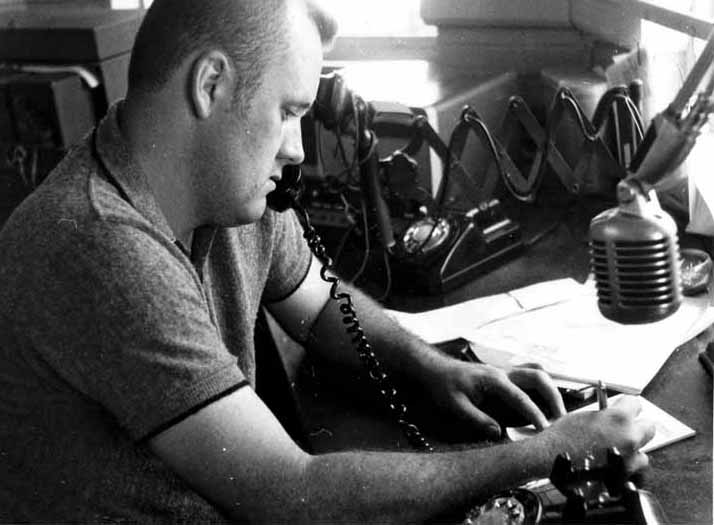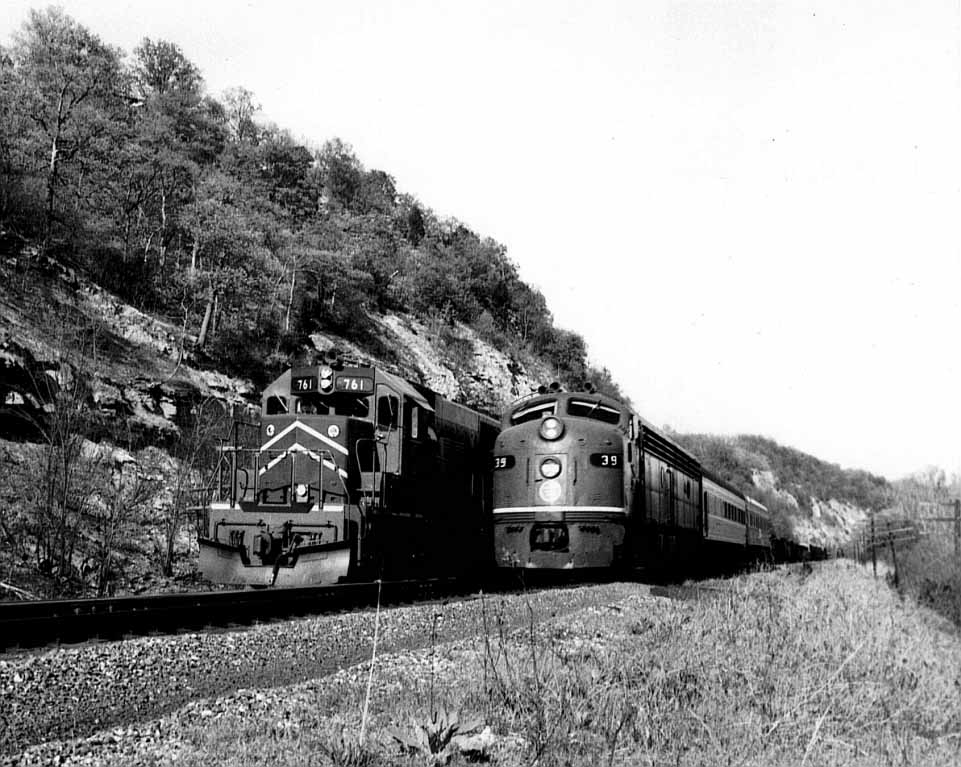Results for {phrase} ({results_count} of {results_count_total})
Displaying {results_count} results of {results_count_total}
Menu

My ambition in my youth was to be a pitcher for the New York Yankees. It never happened so instead I became a telegrapher for the Missouri Pacific Railroad. I was hired on April 18, 1960 at Poplar Bluff, Missouri by Chief Dispatcher Frank Brown Tinsley. The Supt. Was Gale C. Smith who D.B.Jenks demoted later that year and went to Houston as Trainmaster for about 3o plus years. Mr. Smith was too nice a guy for Jenks liking.
I took the first book of rules at the old Poplar Bluff RR YMCA on April 23, 1960 under Trainmaster John Dunlop. I was first called to work 2nd trick at Davis Street Junction on May 17, 1960. The duties at Davis Street were to line trains thru the interlocking with a strong arm (Armstrong Interlocking Plant) and copy and deliver train orders to South Bound and Northbound Trains, get consist from Southbound Trains and deliver much of the info to the dispatcher in Poplar Bluff. But the first thing I did was to line up Tr#4 around to Oakhill towards Tower Grove. On January 26, 2002 the last thing I did on the railroad was to hand line that switch on Local Freight LSE-57 for our move up the Lesperance Street Line. Not much of advancement for 41 years and 10 months on the railroad.
I also had to hand up orders Northbound to Tr#4 advising them that there was track material on the right of way between Davis Street Junction and Tower Grove. That night I also handled Trs# 8, 21, 22, and 37 and local freight No#94 as well as various Ivory Switch Engine moves in both directions. In addition by means of a knife switch we controlled the crossing Gates at Davis Street with lots of traffic going in and out of St. Louis Ship Building which was located between the railroad and the river. They built tow boats. In addition south of the ship builders was Great Lakes Carbon which produced industrial coke which they shipped out in hopper cars. They had one or two bottle steam engines they used to switch their yard and occasionally they would make long moves up North of Davis Street on the Mo Pac Industry track that paralleled the main lines. So you had to be alert to lower the crossing gates for their movements as well as the Missouri Pacific Movements.
I worked 2 second tricks at Davis Street and the one third trick and then I worked 3 thirds at Carroll Street Tower and for six days I grossed $116.16. I was off and running.
The telegraphers extra board was a strict seniority board with the oldest fellow on the board working almost full time and the fellows on the bottom of the board working a few days here and a few days there, except if you were lucky enough to catch a vacation at or on a agents vacation you could not be bumped by a senior man until the vacation was over if the agent elected to take a few extra days off.
The end of May 1960 brought a little change to the roster. The fellows that had served in World War 1 were receiving a pension from the Federal Government. If they continued to work they would lose the pension. So the First Trick Dispatcher at Poplar Bluff (FEM) Frank McDonald, the operator at Sikeston, C. Elliott and the Agent at Bertrand Leo Schwab all retired. AS a foot note Mr. McDonald had been the General Manager of Mo Pac Bus Lines until it was sold to Trailways and then came back to his operator’s and dispatcher’s seniority. To compensate for the three retirements the company cut off three operators jobs. The daylight (first Trick) operators at Bismarck and Sikeston were abolished. In addition there was a long swing job that had worked the operators’ job at Arcadia-Ironton on Monday, 3rd trick at Carroll Street Tower on Thursday, and 3rd trick at Davis Street on Friday in addition it worked one day at Desoto on Sunday and one day at Bismarck. After the cuts it left the 2 days in St. Louis and the one 3rd at Arcadia-Ironton. If you were lucky enough to catch those 3 days, plus 2 days unemployment life was sustainable.
In December 1963 I bid in the only regular job I had in 10.5 years as a telegrapher. I was able to hold the swing or relief job at Davis Street Junction until it was abolished in January 1964. I was then able to work as a switchman at Ivory Yard for 3 weeks, and another 3 months at Lesperance Street Yard. In May of 1964 I got called back as a telegrapher on the Missouri Division and stayed there until July 1967 when I surrendered half of my seniority to transfer to the Northern Division (Old Eastern) because there were more job opportunities.
While on the Missouri Division I did have the opportunity to work 2 days on the Missouri-Illinois at Ste. Genevieve and the one day I billed out 107 car loads of lime. The Master of Track and Trains Joe Simon said, “It was estimated they had enough lime to last another 175 years.” Since that was in 1961 that means there is still another 121 years worth left. And I also in 1961 worked one month at Oakdale, Illinois a grain season job on the Missouri-Illinois. And in addition I worked the Operators jobs at MI Shops at Sparta and the Agency at Nashville and Hoyleton.
The first job on the Northern was a 3 week vacation ay Holden, Missouri and my last was 2 months at Pleasant Hill, Missouri which lasted until December 19, 1970. I even worked the 4am operator’s job at Crane, Missouri for 1 month on the White River Divn. All told I had worked in 54 different stations and interlockers in Missouri and Illinois. The Mobile Agencies came along. On December 21, 1970 I was the head brakeman on Tr#79 out of St. Louis to Jefferson City.
Favorite jobs to work as a telegrapher were 3rd trick at Arcadia-Ironton and Agent at Washington, Mo. For 7 months in 1968 where I met my wife.

Photograph taken by Norbert on April 23, 1971. Caption as follows….
Mo Pac Tr#15 Eng39 passing freight Tr#573 with Eng761 at MP 23 on Sedalia Subdivision as it was known then. This was at MP 23 just east of Boyd Crossover. Boyd and the cross over called Park located at Valley Park were removed and replaced with a new crossover at MP 21 called Kiefer Creek named after a nearby creek. This permitted Eastbound Tonnage trains a better run at Kirkwood Hill also. I remember my days on the extra board where if you caught #573 Westbound which was a glorified local with maybe a set out to make, you would come east the next day on Tr#590 a real local and you could figure on getting in your full 14 hours of work. I can remember leaving Pacific at MP 34 after switching the silica sand plant with about 1 hour to work. You would have either 1 or 2 GP7s or GP 9s and you would be right up to your tonnage rating grinding up Kirkwood Hill, and you would just make it to yard limits and then have to wait for a ride to get into the yard office and tie up.
Those engines had amp ratings and depending on how many amps you were drawing in a certain throttle position you were only suppose to keep them at that rating for so many minutes. I don’t remember the ratings but in the red had a short time rating was a short period and I remember one engineer that would reduce the throttle down when the limit was up, resulting in doubling half the train up the hill at a time. And then we had another engineer who use to say you put a rag over the speedometer going downhill and on the amp meter going up hill.
Originally posted by Charlie Duckworth, 16 July, 2014
All Content Copyright © Missouri Pacific Historical Society, 2024, unless otherwise indicated. By using this site, you agree to our Terms of Use and Privacy Policy.
Your membership supports production of our quarterly magazine, The Eagle, our annual calendar, and our continuing efforts to digitize and present our archives.
Regular Members receive 4 issues of the Eagle, MPHS Calendar, member discounts at the Company Store, full access to the MPHS Archives, and access to participate on the MPHS Forums.
Based on 12-month period beginning with receipt of dues
Includes a subscription to our quarterly magazine, The Eagle
New members will receive the current issue of The Eagle upon receipt of dues
Includes a full-color calendar for the following year (issued with 3rd quarter The Eagle)
Includes a 5% discount on many items in the company store
Access to the online MPHS Forums
Available anywhere in the world
Sustaining Members receive all the benefits of Regular Members, plus donate $25 toward MPHS Operating Expenses.
Recognition in The Eagle.
Based on 12-month period beginning with receipt of dues
Includes a subscription to our quarterly magazine, The Eagle
New members will receive the current issue of The Eagle upon receipt of dues
Includes a full-color calendar for the following year (issued with 3rd quarter The Eagle)
Includes a 7.5% discount on many items in the company store
Access to the online MPHS Forums
Available anywhere in the world
Your name listed in The Eagle
$25 of your dues are tax deductible
Eagle Members receive all the benefits of Regular and Sustaining Members, plus donate $50 toward MPHS Operating Expenses.
Recognition in The Eagle.
Based on 12-month period beginning with receipt of dues
Includes a subscription to our quarterly magazine, The Eagle
New members will receive the current issue of The Eagle upon receipt of dues
Includes a full-color calendar for the following year (issued with 3rd quarter The Eagle)
Includes a 10% discount on many items in the company store
Access to the online MPHS Forums
Available anywhere in the world
John Bromley print (new members, not renewals)
Your name listed in The Eagle
$50 of your dues are tax deductible